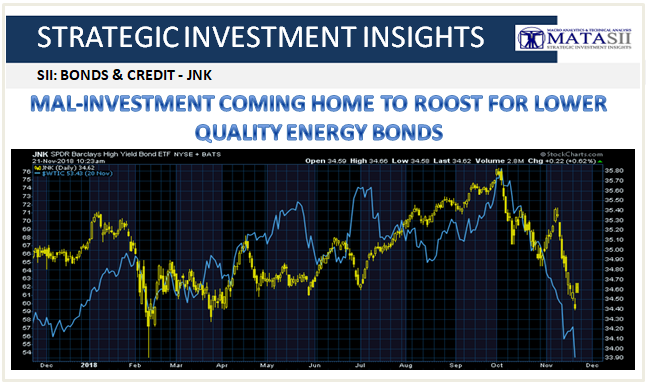MAL-INVESTMENT COMING HOME TO ROAST FOR LOWER QUALITY ENERGY BONDS
A PUBLIC SOURCED ARTICLE FOR MATASII (SUBSCRIBERS-SII & PUBLIC ACCESS) READERS REFERENCE
SII - BONDS & CREDIT - JNK, HYG
11-25-18 - RealInvestmentAdvice.com Lance Roberts - "Oil Sends A "Crude Warning"
MATASII TAKEAWAYS:
- Oil companies have been feasting off the extraordinarily low interest rate environment to leverage up to chase marginally productive drilling in high-depletion rate shale wells (i.e MAL-INVESTMENT),
- Energy-related bonds make up about 15% of the high-yield index,
- With a substantial number of corporate bonds on the verge of falling below BBB ratings in the months ahead, the potential impact of falling energy prices (a reduction in revenue) and higher borrowing costs is a potential double-whammy to an important sector of the economy,
- There is also a danger here to many insurance companies as their credit rating could be downgraded, if more of the bonds that they own are reclassified as ‘Junk.,
- Baa3 grade corporate debt outstanding has now reached an ‘unprecedented’ 56.8% of speculative-grade, or ‘junk,’ high-yield corporate bonds outstanding. By comparison, the ratio of outstanding Baa3 rated bonds to high-yield bonds was 32.5% before the 2008-2009 financial crisis, 36.9% before the 2001 recession and 22.2% before the 1990-1991 downturn,
- The U.S. investment-grade corporate-bond market is now riskier than it was before each recession since 1981 and possibly all prior downturns through the late 1940s,
- Going to make already nervous lenders even more adverse to lending to the sector.
- Demands to shore up credit-lines, increase loan covenants, provide additional collateral, or simply increase borrowing costs could have a materially negative impact on the sector as a whole.
MAL-INVESTMENT COMING HOME TO ROAST FOR LOWER QUALITY ENERGY BONDS
There is an enormous problem currently for the oil and gas sector currently at risk – the debt.
For the last few years, oil companies have been taking of the extraordinarily low interest rate environment to leverage up to chase marginally productive drilling in high-depletion rate shale wells.
Since energy-related bonds make up about 15% of the high-yield index, and with a substantial number of corporate bonds on the verge of falling below BBB ratings in the months ahead, the potential impact of falling energy prices (a reduction in revenue) and higher borrowing costs is a potential double-whammy to an important sector of the economy.

Mark J. Grant recently made some interesting points on this issue:
“Moody’s said the amount of U.S. corporate bonds outstanding, rated at its lowest investment-grade level of Baa, rose to a record $2.83 trillion in the third quarter, topping the $2.62 trillion in single A corporate bonds and the $629 billion in outstanding bonds rated Aa or higher. Within the Baa group, the dollar amount of bonds rated Baa3, Moody’s lowest investment grade rating, ballooned by 140% from the fourth quarter of 2007 to a record $705 billion, in 2018’s third quarter.
Here again, the Fed is not helping, as they are driving up borrowing costs for all of these companies, across the board. There is also a danger here to many insurance companies as their credit rating could be downgraded, if more of the bonds that they own are reclassified as ‘Junk.’ Here is another ‘doom-loop’ scenario that is playing itself out as yields rise and now gap out, in many credits, versus Treasuries.
Baa3 grade corporate debt outstanding has now reached an ‘unprecedented’ 56.8% of speculative-grade, or ‘junk,’ high-yield corporate bonds outstanding. By comparison, the ratio of outstanding Baa3 rated bonds to high-yield bonds was 32.5% before the 2008-2009 financial crisis, 36.9% before the 2001 recession and 22.2% before the 1990-1991 downturn. Startling figures, no doubt.
Moody’s stated:
Thus, from the perspective of dollar amounts outstanding, the U.S. investment-grade corporate-bond market is now riskier than it was before each recession since 1981 and possibly all prior downturns through the late 1940s. Greater uncertainty surrounds the sustainability of corporate earnings growth has adversely affected the performance of medium- and lower-grade bonds. Not since September 2016 has the long-term Baa industrial spread remained above 200 basis points on a recurring basis.”
The collapse in oil prices, which is a direct impact to revenue for oil and gas companies, is going to make already nervous lenders even more adverse to lending to the sector. Secondly, demands to shore up credit-lines, increase loan covenants, provide additional collateral, or simply increase borrowing costs could have a materially negative impact on the sector as a whole.

